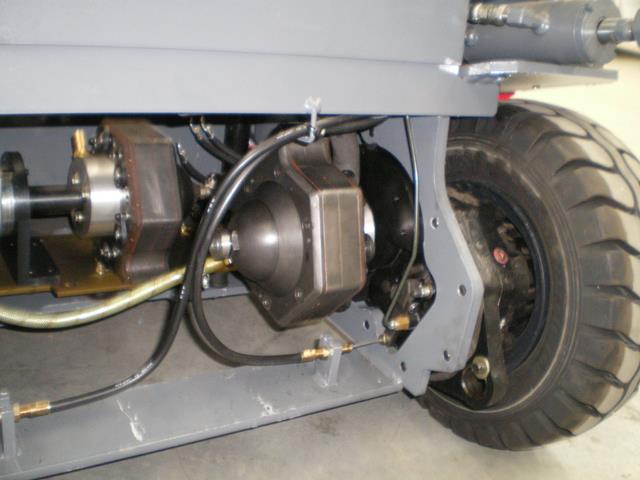 The forklift is an ideal vehicle to use the technology Di Pietro has developed. |
Forget hydrogen fuel cells: the future for forklifts has to be Australian inventor Angelo Di Pietro's air motor technology based on his unique rotary piston concept.
It sounds too good to be true, but the Engineair motor has virtually eliminated vibration, internal wear and friction, and produces no emissions.
It's cheap to run too - air is everywhere and free. The only cost is the energy used for compression. With modern compressors, this process can be very efficient and the energy could come from a green source such as solar or wind which would totally eliminate CO2 emissions. The compressed air drives the motor without any combustion or harmful exhaust gases, the perfect solution to a clean and healthy working environment.
Di Pietro has appeared on numerous television shows to demonstrate the technology, winning the ABC's New Inventors show in 2004.
He has already demonstrated its efficiency in running a motor vehicle, a market trolley, a garden utility truck, a motor scooter and a lawn mower - the next step is to develop a forklift running on compressed air, a project Di Pietro and his associate Dr James Ma, a physicist, are already tackling.
Ma tells
Forkliftaction.com News that the forklift is an ideal vehicle to use the technology Di Pietro has developed, particularly in warehouse applications where zero pollution is highly desirable.
He says the project should be completed by early next year and, if successful, the team will contact forklift manufacturers to perform a full demonstration.
"The forklift we're converting will be powered by three special air motors, which replace the three electric motors in the original Nichiyu forklift. So, instead of a battery supplying electricity, we use air cylinders supplying compressed air."
The advantages of a compressed air forklift over an electric forklift are numerous. Batteries are expensive, take hours to be charged and have a limited life of no more than 2,000 charge cycles. Compressed air can be charged up in a matter of minutes from a filling station. Air tanks virtually have an unlimited life and can be filled and refilled hundreds of thousands of times. Because forklifts need the counterbalance weight, low-cost steel tanks can be used instead of expensive carbon fibre tanks, making it economically feasible. A major problem with compressed air vehicles is availability of compressed air over long distances. In a warehouse environment, this problem does not exist as forklifts do not travel far. A compressor with air storage tank is all that is needed as a filling station. For large sites, the compressor could take advantage of cheap off-peak power at night time and store the compressed air for use during the day.
Ma believes the hype over hydrogen fuel cells will soon be forgotten once the advantages of compressed air become apparent.
"There is a lot going on in America and Europe on hydrogen fuel cell forklifts, and the advantages of fuel cell over battery is now well known. Compressed air forklift will retain all the advantages of fuel cell plus much more. It does not use hydrogen, which is the biggest problem, and the fuel cell itself is expensive and has a limited life as well.
"Sure, compressed air has a lower energy density than hydrogen. But air is free - the only cost is the energy to compress the air. For a warehouse environment, a compressed air forklift is a very viable proposition."
The biggest obstacle that Di Pietro has to overcome in converting the forklift to use compressed air is to ensure it can carry enough to run a reasonable shift.
Ma tells
Forkliftaction.com News that the forklift they're currently converting can run for two hours continuously.
"If a longer running time is required, we can just add more air tanks and increase the air pressure. At the moment we have 150 litre tank capacity at a pressure of 350 bar. But with a filling time of one to two minutes, it is really not a problem. "
Typically, greener options usually carry a heavier price tag but Ma says this type of forklift will be price-competitive once in production.
"At the moment, it's costing us $3,000 on three air tanks, we supply our own air motors (and) we save $5,000 on the battery. Once mass produced, the cost of an air compressed forklift will be comparable to or cheaper than a battery electric forklift. With the almost instant recharging time and long operating life, compressed air forklifts will be more productive, cost effective and save money in the short term and long term.
"We hope to turn the whole world onto running compressed air forklifts wherever possible," he concludes.